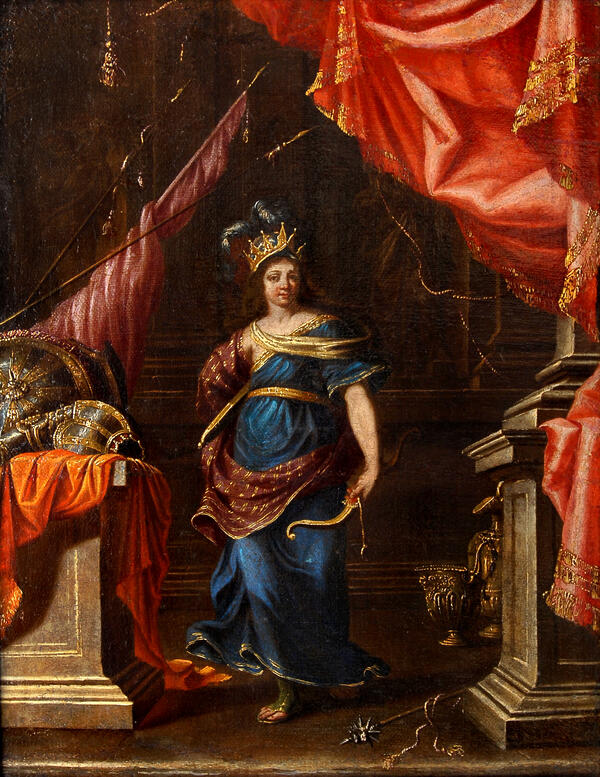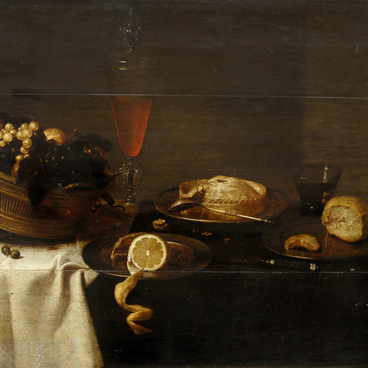“Diana” by an unknown artist represents the French school of painting in the collection of the Primorye Art Gallery. Presumably, the work is related to the famous French school of Charles Le Brun.
Charles Le Brun was a French painter, muralist, sculptor, head of the French art school, and a student of the famous portraitist Simon Vouet. The talent of the aspiring artist was noticed by the master Nicolas Poussin, which gave Le Brun an opportunity to go to Rome with Poussin and work there under the famous painter for several years. Upon his return to his homeland, Le Brun entered the service of Cardinal Mazarin known for his intrigues and the title of a cunning courtier. Thanks to a combination of circumstances and the patronage of Jean-Baptiste Colbert, Charles Le Brun became the head of the Royal Academy of Painting and Sculpture in Paris, the Gobelins Manufactory, and the French Academy in Rome. Having fulfilled a number of major orders of King Louis XIV of France, Le Brun was ennobled and granted a lifetime pension. Le Brun became the leading painter of the royal court. The chief painter strictly monitored the activities of the artists who worked under his guidance, thereby shaping the artistic tastes of the court.
Le Brun’s painting is characterized by the austerity of composition and theatricality combined with decorative splendor in the spirit of the Baroque. The word “baroque” is of Italian origin and literally means strange or bizarre. This name is consistent with the features of the main stylistic trend in European art from the late 16th to the mid-18th century. The Baroque style in France is most inherent in portraiture. Two paired portraits from the gallery’s collection — “Diana” and “Mars” by an unknown master — can serve as examples. Baroque features are clearly visible in these works: the brightness of colors, the dynamism of the composition; the solemnity of draperies and entourage is used to give weight and significance to unknown models depicted as Roman deities.
Charles Le Brun was a French painter, muralist, sculptor, head of the French art school, and a student of the famous portraitist Simon Vouet. The talent of the aspiring artist was noticed by the master Nicolas Poussin, which gave Le Brun an opportunity to go to Rome with Poussin and work there under the famous painter for several years. Upon his return to his homeland, Le Brun entered the service of Cardinal Mazarin known for his intrigues and the title of a cunning courtier. Thanks to a combination of circumstances and the patronage of Jean-Baptiste Colbert, Charles Le Brun became the head of the Royal Academy of Painting and Sculpture in Paris, the Gobelins Manufactory, and the French Academy in Rome. Having fulfilled a number of major orders of King Louis XIV of France, Le Brun was ennobled and granted a lifetime pension. Le Brun became the leading painter of the royal court. The chief painter strictly monitored the activities of the artists who worked under his guidance, thereby shaping the artistic tastes of the court.
Le Brun’s painting is characterized by the austerity of composition and theatricality combined with decorative splendor in the spirit of the Baroque. The word “baroque” is of Italian origin and literally means strange or bizarre. This name is consistent with the features of the main stylistic trend in European art from the late 16th to the mid-18th century. The Baroque style in France is most inherent in portraiture. Two paired portraits from the gallery’s collection — “Diana” and “Mars” by an unknown master — can serve as examples. Baroque features are clearly visible in these works: the brightness of colors, the dynamism of the composition; the solemnity of draperies and entourage is used to give weight and significance to unknown models depicted as Roman deities.



